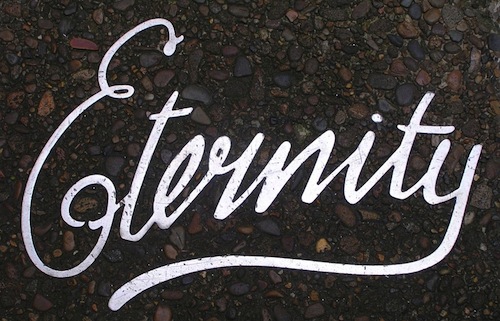I want to take a break from looking at alternative views of hell for a couple of days. I want to do this because I want to deal with the idea of eternity in a couple of posts, not just one.
Eternity, theologically, is wrapped up in a discussion of time. Time and eternity are “two complementary categories for comprehending the historical process.” [1] And the most used word in the Greek when discussing eternity is the word whose root is aion.
When discussing the idea of eternity in the Old Testament, the Hebrew word is yolam. According to the New International Dictionary of Old Testament Theology & Exegesis (NIDOTE), “the basic meaning of the nominative case [noun or subject] is farthest time. It does not seem to mean eternity in the philosophical sense (i.e. neither unbounded time nor eternal timelessness) although there are a few verses where the meaning of the nominative is very much like the idea of eternity.” [2] In most cases, the word is associated with events, usually events extended to the distant past or future. “This distant time is clearly relative; it can be a time in one’s own life (Ps. 77:5), a life span (Exod 21:6), or the furthest conceivable time (Exod 15:18).” [3]
The term is relational, not abstract. Referencing yolam in the phrase “eternity to eternity” – maybe better understood as generation to generation – (I Ch. 16:36, 34, 15; Exod. 40:15), the New International of New Testament Theology (NIDNTT) notes that eternal is “not a question of an eternity conceived of in abstract and infinite terms, but of one’s life and praise in relation to God. 1 Samuel 2:340 and 3:13 show clearly enough that the ‘content of God’s eternal promises is never an abstract unchangeability but a mutual relationship with men; as long as it is intact, it is eternal, but it can fall to pieces.'” [4] Even the great promises which are established forever, “are not simply timelessly and irrevocably valid. They remain bound to their living point of reference in the living God (1 Ki. 9, the eternity of the temple is bound to God’s living presence; 2 Samuel 7, the eternity of the monarchy). Human life is limited (Gen. 6:3); it cannot therefore be the ground of endless duration. But because God lives (the eternal God is the living God), his action and his salvation are eternal (Is. 45:17), his covenant endures (Is. 55:3), and his will is incontestable (Exod. 12:14 ff. ; 27:21).” [5] Therefore, all time is related to the action in history of the living God (Joel 2:1ff.)
In the Old Testament, time is inherently relational, with its temporality wrapped up in the timelessness of God. By our relationship to God and as people created in the image of God, eternity has been set in our hearts (Ecclesiastes 3:11), though in our brokenness and possibly our created-ness we only see a limited perspective.
NOTES:
[1] The New International Dictionary of New Testament Theology, Vol 3, pg 826.
[2] New International Dictionary of Old Testament Theology and Exegesis (5 volume set), Vol. 3, p 346.
[3] Ibid.
[4] The New International Dictionary of New Testament Theology, Vol 3, pg 826.
[5] Ibid.

